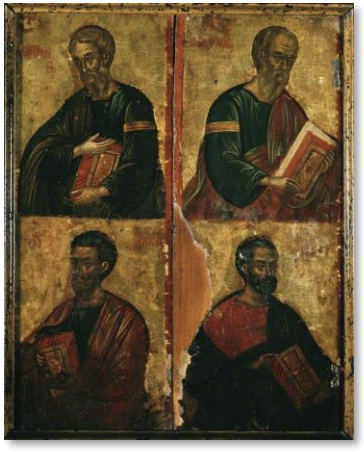The Particularity of Each of the Gospels
God’s written Word, the Word that transforms us, is rich and variegated. Many of the larger biblical books contain within them smaller forms—hymns, parables, visions, and so on. This is true of the Gospels as well. As we listen to them, we come to see that each gospel is a kind of macro-genre: it includes genealogies, teaching passages, passion narratives, healing and miracle stories about Jesus, apocalyptic discourses, parables that Jesus told, infancy narratives in the case of Matthew and Luke, resurrection appearances, and so on. Papias, who wrote about 125 A.D., is recorded by the later historian Eusebius as quoting a certain elder (presbyter), who passed down a tradition about the purposes of the writer Mark:
Mark, who was the interpreter of Peter, wrote down accurately, though not in order, what he heard from Peter that the Lord said and did. For he had not heard the LORD or followed him, but later had followed Peter, who formulated Jesus’ teachings in the form of anecdotes, but not as a finished composition. So, then, Mark did not fail by writing this way certain things as he recalled them, for he had one purpose, not to omit what he heard or falsify anything among these things. These things are reported about Mark…. but about Matthew it has been said that he used testimonies from the first epistle of John and also from that of Peter.1

Mark’s Gospel, the shortest, jumps right to Jesus’ mission, bypassing the nativity stories, and is composed in two great overlapping movements: the first part, from chapters 1 through 8, answers the question “Who is this?” (answer: the Messiah); the second part, from chapters 8 through 16, answers “What kind of Messiah is this?” by insisting that Jesus, the true Messiah, had to suffer and die.
The Evangelist Luke, it seems, was aware that not all the gospels, perhaps including Mark, aspired to present things in strict chronological order, and says that one of his purposes was to research everything thoroughly, and to compose a detailed and “orderly” composition. (Indeed, his is a two-volume work, with the life of Jesus being extended in the Acts of the Apostles, where we see the apostles preaching the Gospel and healing, and the Holy Spirit falling on all believers.) In contrast to Luke’s concentration on ordering all the material he can find, the Evangelist John appears to lift the veil for us so that we can see the spiritual meaning of a select number of stories and sayings. So that we would not forget the entire history of God’s people, or the blessedness of the fathers and mothers of Israel, the Evangelist Matthew concentrates on the continuity between the stories of the patriarchs, the kings, the exile, and the coming of the Lord. To accept Matthew is to reject the campaign of that ancient heretic Marcion, who said that nothing from the Old Testament had any validity for God’s people! It is to remember that God’s storehouse has things in it “both old and new” (Matt 13:52), and that a wise householder knows when to pull out and delight in each treasure.
We have a fourfold and complementary witness to the mighty acts of God and should be grateful for the fathers’ wisdom in recognizing that we need all four gospels. In the ancient days of the Church, a man called Tatian composed a gospel harmony, called the Diatessaron (literally, “through the four”), which attempted to combine the four gospels into a single running narrative. This format may have been more logical but obscured the richness and variety of the four evangelists. It was not this rationalized harmony, but the four gospels, with all their differences and complementarities, that were bequeathed to the Church as the fathers recognized which writings were “canonical”—that is, which truly communicated the canon of truth and faith.
Footnotes
-
Eusebius, Church History. 3.39.14–15 ↩